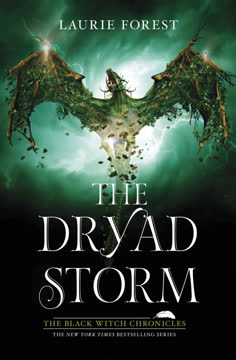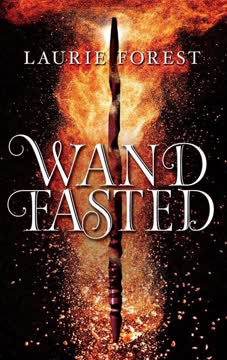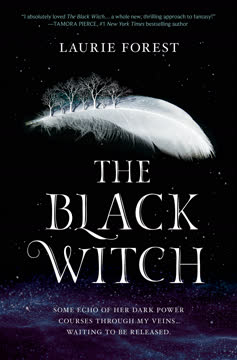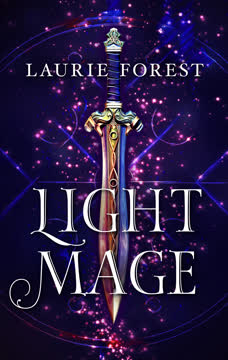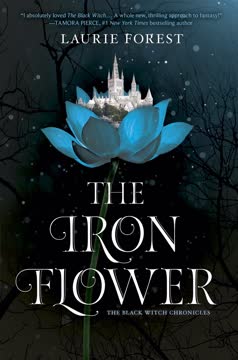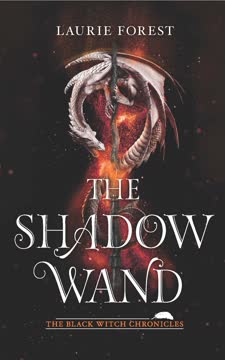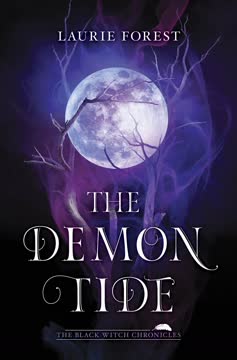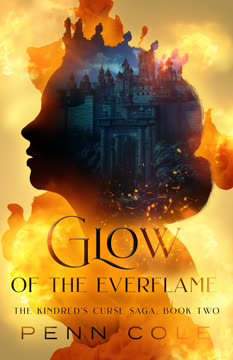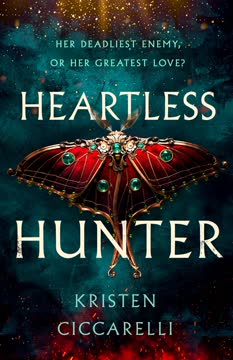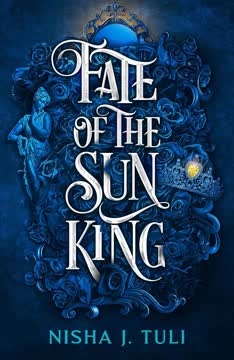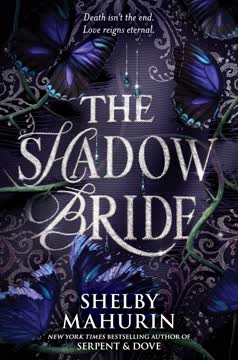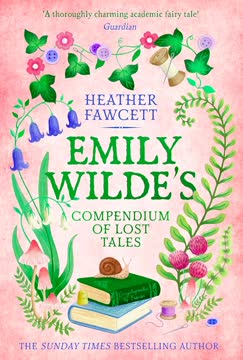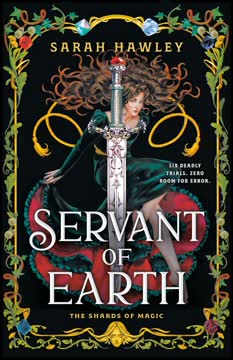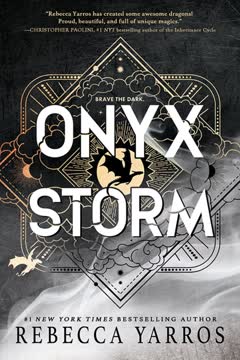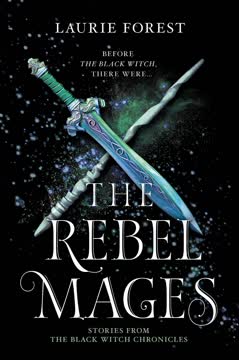Plot Summary
Forests Burn, Bonds Break
The novel opens in chaos as the Magedom, led by Marcus Vogel, unleashes Shadowfire and monstrous dragons upon the city of Cyme and the surrounding Caledonian Forest. Alder Xanthos, a Dryad'kin, is forced to flee as her beloved Forest and eagle kindred, Azion, are destroyed before her eyes. The devastation severs her rootlines, nearly killing her, and she is dragged to safety by her friend Vestylle. The trauma of losing her Forest and kindred leaves Alder broken, but the purple Vo Forest offers her a new bond and a battered flock of Saffron Eagles. As the Shadow spreads, Alder and her new kindred vow to fight for the surviving wilds, even as the world's forests fall to the Magedom's relentless assault.
Shadow Wand Ascendant
Marcus Vogel, now wielding the Shadow Wand, experiments with its ability to siphon elemental magic from forests and Dryads, turning their power into Void. He fastens his control over the Magedom, using Shadow to corrupt and bind his followers, and forcibly fasts Elloren Gardner Grey, the Black Witch, to himself. The Shadow Wand's influence grows, consuming not only land but the hearts and minds of Mages, as Vogel prepares to fulfill the ancient Prophecy by pitting the Black Witch against the Icaral demon, Yvan Guryev. The Shadow's reach is now planetary, threatening forests, waters, and skies alike.
Waters Under Siege
The Magedom's Shadow sea weapon rolls over the Western oceans, killing and mutating marine life, and threatens to invade the East. Gareth Keeler, a half-Selkie Mage, and his beloved Marina, a Selkie, discover that only by merging their powers—through love and the magic of water-bound trees—can they unlock Gareth's true water magic. Their union, under the Xishlon moon, allows Gareth to breathe underwater and wield immense power, just as the Shadow sea attacks. With the help of Storm Whales and the mangroves, they create a lightning barrier to hold back the Shadow, but the threat to Erthia's Waters and the interconnected Natural Matrix is only beginning.
Mage Rebellion Ignites
In Valgard, Gwynnifer Croft Sykes, a Level One Light Mage, witnesses the horrors of the Magedom's regime and the torture of Fae children. Betrayed by her family and fastmate, she joins the Resistance, led by the charismatic and powerful Mavrik Glass. Together, they orchestrate a daring attack on the Mage armory, rescue mutilated Urisk girls, and flee into the Sublands. Their magical connection intensifies, hinting at a deeper, fated bond. As the Magedom's Shadow closes in, Gwynn and Mavrik's alliance—and their forbidden attraction—become a beacon of hope for the oppressed.
The Verdyllion's Call
Across Erthia, visions and dreams of the Verdyllion—the legendary Wand-Stylus—call its Bearers to unite. Wynter Eirllyn, an Icaral Elf, wields the Verdyllion and leads a diverse group of rebels, including Gwynn, Mavrik, Valasca, and Sparrow, through the Sublands. The Wand's power is amplified by the light magic of its Bearers, and it becomes clear that only by joining their unique magics—across bloodlines, cultures, and old hatreds—can they hope to counter the Shadow Wand. The Verdyllion's true strength lies in connection, empathy, and the breaking of ancient cycles of division.
Foliage and Fire Unleashed
As autumn's prismatic foliage surges, Dryad'khin across Erthia experience a dramatic amplification of their magic. Elloren, now transformed into a Dryad Witch, and Yvan, the Icaral of Prophecy, unite their powers and hearts, forging a Wyvernbond that links fire and forest. The Zhilaan Forest, the last great wild, becomes the stronghold for the united Dryad'khin army. But the Magedom, now led by the true Black Witch, Fallon Bane, and the Shadow Wand's V'yexwraith demon, prepares to strike with Void moons—Shadow-iron explosives—threatening to annihilate the last hope for the Natural World.
The Great Unraveling
The Eastern Realm's attempt to wall out the Shadow with a massive storm band backfires, as the V'yexwraith demon consumes the storm's power and unleashes chaos. The Dyoi Forest and Zonor River are destroyed, the Natural Matrix unravels, and Deathkin—like Hazel and Viger—are forced to dissolve into Nature to hold off a Reckoning. The world teeters on the brink of total collapse, with only a few stands of living Forest and the Vo River's shielded waters remaining. The survivors, battered and divided, must find a way to restore Balance before all is lost.
Prophecy Rewritten Together
The ancient Prophecy, once a tool of division, is rewritten through collective action. The Verdyllion's Bearers—Elloren, Wynter, Sage, Gwynn, Mavrik, Rivyr'el, and Marina—channel their light power into the Wand, breaking the Shadow's hold over the Mages and Alfsigr. The Shadow Wand's V'yexwraith is defeated by the combined might of geomancy, Deathkin, and love. The cycle of hate and fracture is broken as the runic border walls fall, and the peoples of Erthia unite as Dryad'khin, committed to healing the world and each other.
Void Moons, Death Reckoning
As the Void moons threaten to destroy all, the Deathkin—Hazel, Viger, Sylla, and others—sacrifice themselves, merging with Nature to stave off the Reckoning. Their act buys time for the Dryad'khin to plant new trees, restore the Matrix, and rewild the land. The Shadow Wand, now encased in stone and guarded by all peoples, becomes a warning: fracture and hate will always call it forth. Only love, connection, and the courage to face one's fears can keep the Shadow at bay.
The Last Stand: Unity
In the aftermath, the survivors—Dryad, Mage, Fae, Urisk, Selkie, Lupine, and more—work together to heal Erthia. The Great Tree IV rises in Voloi, anchoring a new Balance. Former enemies become kin, and love—across boundaries of blood, culture, and magic—becomes the world's greatest power. The Xishlon moon's festival celebrates not just romance, but the hard-won unity of a world that nearly destroyed itself. The next generation, led by Valen and Fern, inherit a world where hope is possible, but vigilance and connection are essential.
IV: New Roots Rising
The Verdyllion, now rooted as the Great Tree IV, becomes the living heart of Erthia's restoration. Its roots connect all peoples, and its power is sustained by the ongoing choice to love, forgive, and work together. The Shadow Wand remains, ever waiting for division to call it forth, but the world's new Dryad'khin resolve to guard against the old cycles. The story ends with a call to the reader: the Forest's Wand is calling to you. The beginning of a new story, for all of us.
Xishlon Moon's Hope
Under the Xishlon moon, the peoples of Erthia celebrate survival, love, and the promise of renewal. Old wounds are tended, new bonds are forged, and the work of rewilding and healing continues. The moon's light is a reminder that hope, like the Forest, must be nurtured and protected. The next generation—children of every lineage—grow up in a world where difference is strength, and the Balance is everyone's sacred charge.
The Next Great Mage
The epilogue follows Valen, a child of war and trauma, as he is adopted and healed by the diverse peoples of the new world. As he comes of age, he is courted by the remnants of the old Magedom, who urge him to reclaim their lost power. But Valen, shaped by love and connection, chooses instead to join the Lupine pack and mate with Fern, a geomancer. The story closes with a call to all: the Shadow Times are always here, but the Verdyllion's path—of unity, courage, and love—is open to all who choose it.
Characters
Elloren Gardner Grey
Elloren is the granddaughter of the infamous Black Witch, initially powerless and naive, shaped by trauma, loss, and the slow awakening of empathy. Her journey is one of transformation—from Mage to Dryad Witch, from pawn of prophecy to active rewriter of destiny. Her relationships—with Yvan, Lukas, her friends, and her enemies—are marked by deep psychological struggle: guilt, grief, the longing for belonging, and the courage to break cycles of hate. Elloren's greatest power is her ability to connect, forgive, and unite, making her the living embodiment of the Verdyllion's call.
Yvan Guryev
Yvan is the prophesied Icaral demon, but his true nature is far more complex: part Lasair, part healer, part revolutionary. His love for Elloren and his struggle with his own identity—hated, hunted, and yet essential—mirror the world's need to embrace difference. Yvan's fire is both destructive and life-giving, and his journey is one of learning to wield power with compassion, to love fiercely, and to fight for a world where he and others like him can belong.
Marcus Vogel
Vogel is the architect of the Magedom's Shadow regime, wielding the Shadow Wand to consume, corrupt, and divide. His psychological profile is one of zealotry, control, and the terror of his own Icaral nature. Vogel's rise and fall are a study in the dangers of unchecked power, the seduction of prophecy, and the self-destructive nature of hate. Even in defeat, his legacy warns that the Shadow is always waiting for division to call it forth.
Gwynnifer Croft Sykes
Gwynn is a Level One Light Mage whose journey from loyal daughter and fastmate to Resistance fighter is marked by betrayal, trauma, and the slow, painful awakening to the Magedom's horrors. Her bond with Mavrik Glass is both magical and emotional, a partnership forged in fire and rebellion. Gwynn's struggle with guilt, faith, and the courage to love again is emblematic of the book's central theme: the necessity of breaking with the past to build a better future.
Mavrik Glass
Mavrik is a powerful, charismatic Mage whose mastery of multiple magics and runes makes him a key figure in the Resistance. His psychological complexity—marked by loss, anger, and a fierce sense of justice—drives him to risk everything for the oppressed. His relationship with Gwynn is both a source of strength and vulnerability, and their twinned magic becomes a metaphor for the power of connection to overcome even the most entrenched divisions.
Wynter Eirllyn
Wynter is a survivor of trauma and oppression, her empathic abilities allowing her to read and channel the intentions of others. As the Bearer of the Verdyllion, she becomes a linchpin in the fight against the Shadow, her journey one of reclaiming agency, forging unlikely alliances, and learning to wield power for healing rather than destruction. Her love for Ariel and her role as Ealaiontora (spiritual leader) mark her as a symbol of hope and new beginnings.
Alder Xanthos
Alder's story is one of profound loss—the destruction of her Forest and kindred—and the slow, painful process of healing and re-rooting in a new land. Her empathy, courage, and willingness to fight for the wilds make her a key figure in the Dryad'khin resistance. Alder's psychological journey is marked by grief, survivor's guilt, and the rediscovery of purpose through new bonds and the call to protect what remains.
Gareth Keeler & Marina
Gareth and Marina's love story is a microcosm of the book's central message: only by merging differences—land and water, Mage and Selkie, tradition and change—can true power be unlocked. Their union, under the Xishlon moon, becomes the key to unlocking Gareth's water magic and holding back the Shadow sea. Their relationship is marked by longing, sacrifice, and the courage to risk everything for love and the greater good.
Or'myr Syll'vir & Tierney Calix
Or'myr and Tierney's bond—complicated by incompatible magics, cultural divides, and the trauma of war—becomes a symbol of the possibility of healing and connection even in the face of seemingly insurmountable obstacles. Their journey, from friends to lovers to partners in restoring the Vo River and the land, is marked by humor, longing, and the willingness to face their deepest fears together.
Hazel & Wrenfir
Hazel's role as a Deathkin—able to hold off the Reckoning by merging with Nature—embodies the book's exploration of death, balance, and the cost of survival. Wrenfir's journey, from anger and loss to love and hope, is a testament to the power of vulnerability and the necessity of facing grief to heal. Their relationship, marked by separation and reunion, is a reminder that love can bridge even the darkest divides.
Plot Devices
Prophecy and Subversion
The ancient Prophecy—of the Black Witch and the Icaral demon—is a central plot device, used by those in power to justify violence and division. Throughout the novel, characters struggle with the weight of prophecy, only to ultimately rewrite it through collective action, love, and unity. The subversion of prophecy becomes a metaphor for breaking cycles of hate and forging new destinies.
The Verdyllion and Shadow Wand
The Verdyllion (Wand of Myth) and the Shadow Wand are opposing magical artifacts, each with their own network of influence. The Verdyllion's power is amplified by connection, empathy, and the joining of diverse magics, while the Shadow Wand feeds on division, hate, and the siphoning of elemental power. The struggle to unite the Bearers of the Verdyllion and break the Shadow's network is the novel's central narrative engine.
Twinning, Bonding, and Magical Merging
The novel uses magical twinning, bonding, and the merging of powers—through love, friendship, and alliance—as both plot device and metaphor. Only by joining magics across boundaries (Dryad, Mage, Selkie, Fae, Deathkin, etc.) can the characters unlock new abilities, heal the land, and defeat the Shadow. The narrative structure mirrors this, with multiple storylines converging into a single, unified climax.
Cycles of History and Rebellion
The book's structure is cyclical, with history repeating itself through cycles of hate, war, and environmental destruction. The rebellion—both magical and social—against these cycles is driven by characters who choose to break with the past, forgive, and build new traditions. The fall and rise of forests, the destruction and rewilding of land, and the transformation of old enemies into kin are all foreshadowed and echoed throughout the narrative.
Death Reckoning and Sacrifice
The threat of a Death Reckoning—a natural, magical response to the Unbalancing of the world—serves as both a ticking clock and a warning. The sacrifice of the Deathkin, who merge with Nature to hold off the Reckoning, is a powerful plot device that underscores the cost of survival and the necessity of restoring Balance. The possibility of their return, if the world is healed, offers hope and a reminder that death and life are intertwined.
Analysis
The Dryad Storm is a sweeping, multi-layered fantasy that uses the language of magic, prophecy, and war to explore the deepest fractures of our world—prejudice, environmental destruction, and the cycles of hate that perpetuate suffering. At its heart, the novel is a plea for connection: between peoples, between humans and Nature, and within ourselves. The Shadow is not just an external evil, but the ever-present possibility of division, fear, and the refusal to see the Other as kin. The Verdyllion's power—amplified by love, empathy, and the courage to face one's fears—offers a blueprint for healing: only by joining together, breaking old cycles, and embracing difference can we hope to restore Balance. The book's lessons are clear: history is not destiny, love is the greatest magic, and the work of rewilding—of land, of hearts, of hope—is never finished. The story ends not with a final victory, but with a beginning: the Forest's Wand is calling to all of us, and the choice to answer is ours.
Last updated:
FAQ
Synopsis & Basic Details
What is The Dryad Storm about?
- A World Unraveling: The Dryad Storm plunges Erthia into a desperate struggle for survival as Marcus Vogel, wielding the Shadow Wand, unleashes devastating Shadowfire, corrupting land, water, and magic, pushing the planet towards an ecological collapse known as the Reckoning. The narrative follows Elloren Gardner Grey, now a Dryad Witch, and Yvan Guryev, the Icaral of Prophecy, as they unite diverse factions—Dryads, Mages, Fae, Selkies, Urisk, and more—to form a Dryad'khin army.
- Unity Against Division: The core conflict revolves around overcoming ancient prejudices and cultural divides, as the newly allied forces, guided by the Verdyllion (Wand of Myth), seek to restore the Natural Matrix and defeat the Shadow, which thrives on fracture and hate. The story explores themes of environmental responsibility, the redefinition of prophecy, and the transformative power of love and connection in the face of seemingly insurmountable odds.
- A Fight for Life: From the burning forests of the West to the besieged rivers of the East, characters like Gwynnifer Sykes, Mavrik Glass, Alder Xanthos, Gareth Keeler, Marina, Or'myr Syll'vir, Tierney Calix, Hazel, and Wrenfir navigate profound personal losses and psychological challenges, ultimately choosing to fight for a future where all life, regardless of lineage or magic, can thrive in balance.
Why should I read The Dryad Storm?
- Emotional Depth Explored: Readers should delve into The Dryad Storm for its raw emotional honesty, particularly in depicting grief, trauma, and the arduous journey of healing. The novel doesn't shy away from the psychological toll of war and loss, offering a deeply human core to its fantastical elements, making characters' struggles and triumphs profoundly resonant.
- Subversive Prophecy & Identity: The book masterfully subverts traditional fantasy tropes, especially the "Black Witch" and "Icaral" prophecy, challenging readers to question preconceived notions of good and evil. It offers a fresh perspective on identity, showing how characters transcend their inherited labels and forge new destinies through choice and alliance, providing a rich interpretive debate.
- Ecological & Social Relevance: Beyond its magical battles, The Dryad Storm serves as a powerful allegory for contemporary environmental and social issues, emphasizing the critical importance of ecological balance, interspecies cooperation, and overcoming systemic prejudice. Its intricate world-building and diverse magical systems are woven into a compelling narrative that champions unity and collective action.
What is the background of The Dryad Storm?
- Fractured Magical Systems: The world of Erthia is characterized by diverse magical systems (Mage, Dryad, Fae, Urisk, Selkie, etc.), each with unique affinities and often rigid, conflicting traditions. This inherent magical and cultural division is a key background element, exploited by the Shadow to sow discord and destruction.
- Ancient Religious Conflicts: Deep-seated religious dogma, particularly the Gardnerian "Ancient One" faith and the Noi "Vo'lon" faith, has historically fueled prejudice and war between peoples, leading to cycles of oppression and environmental neglect. The novel's setting is steeped in the aftermath of these conflicts, with characters grappling with inherited hatreds and the legacy of past atrocities.
- Ecological Interconnectedness: Erthia's natural world operates as a "Natural Matrix," where forests, rivers, oceans, and even weather patterns are deeply interconnected. The Magedom's systematic destruction of forests and pollution of waters directly destabilizes this matrix, leading to catastrophic environmental consequences like the "Reckoning," a natural defense mechanism that threatens all life.
What are the most memorable quotes in The Dryad Storm?
- "We stand together as one, or we fall together with all of Erthia.": This quote, spoken by Gareth Keeler in Chapter Seven, encapsulates the novel's central theme of unity in the face of existential threat. It highlights the dire stakes of the conflict and the necessity of transcending historical divisions for collective survival, resonating with the broader message of interconnectedness.
- "The power of religion. Able to make us deny even the most glaringly obvious of truths.": Mavrik Glass's cynical observation in Chapter Ten, reflecting on the Mages' denial of their Dryad lineage, cuts to the heart of the book's critique of dogma and blind faith. It underscores the psychological complexities of inherited beliefs and the difficulty of confronting uncomfortable truths, a key element in the characters' journeys of self-discovery.
- "Your fears are beautiful, Tierney Calix. They always have been.": Viger Maul's poignant admission to Tierney in Chapter Four of Part Two, revealed in a dream, offers a profound insight into the nature of fear and vulnerability. This quote challenges conventional notions of strength, suggesting that acknowledging and embracing one's deepest fears can be a source of unexpected connection and even love, a subtle yet powerful emotional analysis.
What writing style, narrative choices, and literary techniques does Laurie Forest use?
- Immersive Sensory Detail: Forest employs rich, visceral sensory descriptions, particularly of magic, environment, and emotional states, to immerse the reader deeply into the characters' experiences. Phrases like "firestorm kiss," "acrid tang of unnatural smoke," and "soul-shearing cry" create a palpable sense of the world's beauty and its brutal unraveling, enhancing the emotional analysis.
- Multiple Third-Person Perspectives: The narrative frequently shifts between various third-person limited perspectives, offering a kaleidoscopic view of the unfolding events and allowing for deep psychological insight into a wide array of characters. This choice highlights the interconnectedness of individual struggles within the larger conflict, reinforcing themes of unity and diverse experiences.
- Symbolic Language & Foreshadowing: Forest weaves intricate symbolism and subtle foreshadowing throughout the text, often through recurring motifs like colors, animals, and natural phenomena. For instance, the constant "tingling" or "sizzling" of magic often precedes significant character transformations or plot developments, while the changing hues of skin and eyes symbolize deeper shifts in identity and allegiance, inviting deeper interpretive debate.
Hidden Details & Subtle Connections
What are some minor details that add significant meaning?
- The Sanjire Root's Dual Purpose: Initially presented as a holiday pay item for Gareth in Chapter One of Prelude, the Sanjire root later becomes a key element in amplifying Gareth and Marina's love-bonded power during their Xishlon ritual. This seemingly minor detail subtly foreshadows the idea that natural elements, often overlooked or used for mundane purposes, hold deeper, transformative magical potential when aligned with intention and love, connecting to themes of hidden power and natural magic.
- The Watchers' Shifting Allegiance: The translucent Watcher birds, initially associated with the Gardnerian "Ancient One" and often depicted on Mage flags, are later seen perched on the shoulders of Fae and Dryad'khin, and even appear in the dreams of characters like Gwynnifer and Wynter. This subtle shift in their appearance and presence implies that these "messenger birds" are not bound by human religious dogma but align with truth and the "Natural Matrix," challenging the reader's initial interpretation of their symbolism and hinting at a universal spiritual force.
- The Significance of Cropped Ears: The brutal act of cropping Urisk children's ears, detailed in Gwynnifer's backstory in Chapter Two of Prelude, is a seemingly minor act of cruelty that profoundly impacts her and later becomes a symbol of the Magedom's barbarity. The subsequent healing and transformation of characters' ears into "pointed" Dryad Fae ears (e.g., Elloren, Mavrik, Gwynn) subtly signifies their rejection of Mage oppression and their embrace of a new, integrated identity aligned with the Natural World, adding a layer of symbolic meaning to physical trauma.
What are some subtle foreshadowing and callbacks?
- Vogel's Experimentation on Alder: In the Prologue, Vogel is described as "experimenting on her," siphoning Alder's power as her Forest burns. This subtly foreshadows his later, more widespread use of the Shadow Wand to parasitize elemental magic from the entire Natural Matrix, turning it into Void power. It's a callback to the initial act of aggression that sets the stage for the global conflict, highlighting Vogel's consistent methodology.
- The "Unbroken" Motif: The recurring epithet "Unbroken" (e.g., Naga the Unbroken, Raz'zor the Unbroken, Elloren the Unbroken) subtly foreshadows the resilience and transformative power of characters who defy conventional expectations and overcome immense trauma. It's a callback to their individual struggles against literal and metaphorical chains, hinting at their capacity to break cycles of history and emerge stronger, embodying the novel's theme of enduring spirit.
- The "Garden" Metaphor for Intimacy: Or'myr's and Tierney's humorous yet poignant discussions about "the garden" and "gathering many flowers" (Chapter Ten of Part Two) subtly foreshadow the broader cultural shift towards diverse forms of love and intimacy in the post-war Eastern Realm. This is a callback to the rigid, restrictive Gardnerian views on relationships, highlighting the liberation and healing that comes from embracing different expressions of love and connection, a key aspect of the "Xishlon Renaissance."
What are some unexpected character connections?
- Wrenfir and Hazel's Mating Bond: The unexpected romantic and magical bond between Wrenfir, a Mage apothecary, and Hazel, a Deathkin Dryad, is a subtle yet profound connection. Their shared trauma and Wrenfir's initial jadedness give way to a deep love, culminating in Hazel's sacrifice to hold off the Reckoning. This relationship highlights the novel's theme that love can bridge the most seemingly incompatible differences, even between life and death, and offers a fresh perspective on the nature of Deathkin.
- Or'myr and Tierney's Dream-Shared Intimacy: The revelation that Or'myr and Tierney's Xishlon kiss created a bond allowing them to share dreams, including intimate ones, is an unexpected and complex connection. This magical linkage, initially a source of mortification and conflict due to their incompatible physical magic, ultimately deepens their emotional bond and allows them to understand each other's deepest fears and desires, subverting traditional romantic tropes and emphasizing psychological intimacy.
- Valasca's Hidden Love for Ni Vin: The deep, long-standing love between Valasca, the fierce Amaz warrior, and Ni Vin, the stoic Vu Trin sorceress, is an unexpected connection that challenges the Amaz's traditional separation from men and other cultures. Their reunion and Valasca's open declaration of love, despite Ni Vin's past trauma from the Black Witch, highlight the power of love to transcend historical animosity and personal pain, offering a nuanced view of Amaz identity.
Who are the most significant supporting characters?
- Commander Ung Li: As the Wyvernguard commander, Ung Li initially represents the rigid, xenophobic elements of Noi society, but her eventual alliance with the Dryad'khin and her defiance of the Vo Conclave mark her as a pivotal figure in the East's transformation. Her journey highlights the internal struggle within established powers to adapt to new realities and prioritize collective survival over traditional dogma.
- Priest Wyn Juun: This elderly Noi priest, initially a symbol of traditional Vo'lon faith, becomes a crucial bridge between the old ways and the new Dryad'khin alliance. His compassion for the sick refugees and his willingness to embrace the Forest's teachings, despite his Conclave's opposition, demonstrate the potential for spiritual leaders to guide their people towards unity and healing, offering a nuanced view of religious faith.
- Hizar'drile and Gethindrile Xanthile: Vothe's father and brother, these Zhilon'ile Wyvern-shifters initially embody the Zhilaan military's fierce independence and distrust of outsiders, even their own kin who align differently. Their eventual, dramatic realization of the ecological stakes and their subsequent alliance with the Dryad'khin army underscore the novel's theme that even the most entrenched divisions can be overcome when faced with an existential threat, highlighting the power of familial bonds and shared purpose.
Psychological, Emotional, & Relational Analysis
What are some unspoken motivations of the characters?
- Vogel's Desire for Purification: Beyond mere power, Vogel's unspoken motivation is a twisted form of "purification" for himself and Erthia, believing his Icaral nature to be a "Fae corruption" that can only be purged by consuming elemental magic and dominating others. His desire to "purify and transform" Elloren into a "pure and righteously submissive vessel" reveals a deep-seated self-loathing projected onto the world, driving his destructive zealotry.
- Gwynnifer's Quest for Redemption: Gwynnifer's fierce rebellion against the Magedom is driven by an unspoken, profound need for redemption after her complicity in the system and her betrayal of Sage. Her willingness to sacrifice everything, including her family and former life, is motivated by a desperate desire to atone for her past ignorance and contribute to a just cause, revealing a deep psychological complexity.
- Yvan's Longing for Belonging: Despite his prophesied role as the "Icaral demon," Yvan's unspoken motivation is a deep longing for acceptance and belonging, particularly evident in his connection to the fire-loving Zhilaan Forest. His initial reluctance to embrace his full power stems from a fear of destruction, but his bond with Elloren and the Forest allows him to redefine his identity and find a place where his "fire" can be a source of life and protection, not just devastation.
What psychological complexities do the characters exhibit?
- Elloren's Guilt and Self-Doubt: Elloren grapples with immense psychological complexity, particularly her guilt over Lukas's death and her past actions under Vogel's thrall. Her internal struggle to accept her "Black Witch" identity, even as she redefines it, showcases the profound impact of trauma and the difficulty of self-forgiveness, making her journey a deep emotional analysis of overcoming inherited burdens.
- Wrenfir's Jaded Grief and Hope: Wrenfir exhibits a complex psychological state of jaded grief, stemming from the loss of his loved ones and the perceived futility of fighting the Shadow. His initial cynicism and anger are a defense mechanism against further heartbreak, but his love for Hazel and his commitment to healing others reveal a hidden wellspring of hope and compassion, highlighting the intricate interplay of despair and resilience.
- Oaklyyn's Traumatic Rigidity: Oaklyyn's fierce adherence to traditional Dryad ways and her initial hatred of non-Dryad'kin stem from deep-seated trauma and grief over the destruction of her Forest and kindred. Her psychological complexity lies in her struggle to reconcile her rigid beliefs with the new reality of universal threat, eventually leading to a painful but transformative acceptance of broader alliances, showcasing the psychological impact of loss on identity.
What are the major emotional turning points?
- Alder's Re-rooting in the Vo Forest: A major emotional turning point for Alder occurs in the Prologue when, utterly devastated by the destruction of her Caledonian Forest and Azion, she is called by the purple Vo Forest to become its Guardian. This moment of profound grief transforming into renewed purpose, symbolized by her skin regaining its green hue and her bond with Fireling, marks her shift from victim to defiant protector, a powerful emotional analysis of resilience.
- Gwynnifer and Mavrik's Sealing: The decision by Gwynnifer and Mavrik to "Seal" their twinned magic through physical intimacy (Chapter Two of Part Two) is a pivotal emotional turning point. It represents their radical break from Gardnerian religious and cultural norms, transforming their forced fastings into a freely chosen bond of love and power. This act, fraught with personal and magical risk, symbolizes their complete surrender to their true selves and their alliance against the Magedom, highlighting the emotional liberation found in defiance.
- Ariel's Confrontation with Nilantyr: Ariel's struggle against the nilantyr berries, orchestrated by Vogel (Chapter Fifteen of Part Four), is a critical emotional turning point. Her ability to resist the addictive drug by drawing on the collective strength of her horde and her love for them marks her complete reclamation of agency and identity as an "Unbroken Dragon." This moment of fierce self-mastery, overcoming past trauma, is a powerful emotional analysis of healing through communal support.
How do relationship dynamics evolve?
- Elloren and Yvan: From Prophecy to Partnership: Their relationship evolves from a fated, often adversarial dynamic (Icaral vs. Black Witch) to a deep, Wyvernbonded partnership. Initially driven by external forces and mutual suspicion, their bond transforms through shared trauma, vulnerability, and a conscious choice to defy prophecy, culminating in a fully consummated mating that amplifies their power and redefines their roles as "Forest'khin" leaders.
- The Dryads: From Isolation to Inclusion: The Dryads' relationship dynamics shift dramatically from a fiercely isolationist stance, rooted in ancient grievances and a distrust of non-Tree'kin, to one of reluctant then full inclusion. Figures like Sylvan and Yulan, initially wary, embrace alliances with Mages, Fae, and other groups, driven by the existential threat to the Natural World. Oaklyyn's journey from hatred to acceptance, particularly with Raz'zor and Hazel, exemplifies this profound evolution, highlighting the healing of historical fracture.
- The East's Factions: From Conflict to Coalition: The relationship dynamics among the Eastern Realm's diverse factions (Noi, Zhilaan, Amaz, Kelt, Lupine, Selkie, Urisk, Lasair, etc.) evolve from deep-seated mistrust and infighting to a fragile but powerful coalition. Characters like Vang Troi, Freyja Zyrr, Soleiya Guryev, and Iris Morgaine, initially bound by their own cultural and personal agendas, learn to set aside differences and unite against the common Shadow enemy, demonstrating the arduous but necessary path to collective action.
Interpretation & Debate
Which parts of the story remain ambiguous or open-ended?
- The Fate of the Shadow Wand: While the Shadow Wand is encased in stone and guarded, its "strangely silent" and "dormant" state (Chapter Seven of Part Four) leaves its ultimate fate ambiguous. The text explicitly states it "can't be destroyed" and "will remain ever-waiting," implying a perpetual threat that could re-emerge if division and hate resurface. This open-endedness invites interpretive debate about the enduring nature of evil and the continuous need for vigilance.
- The Fullness of the Reckoning: Hazel and other Deathkin dissolve into Nature to "hold
Review Summary
The reviews for The Dryad Storm are largely negative, with many readers expressing disappointment in the final installment of the series. Common criticisms include excessive new characters and storylines, repetitive writing, and a shift away from the main plot. Some readers felt the book was overly long and struggled to finish it. While a few positive reviews remain, the majority found the conclusion unsatisfying, citing issues with character development, pacing, and resolution of major plot points.
The Black Witch Chronicles Series
Similar Books
Download PDF
Download EPUB
.epub digital book format is ideal for reading ebooks on phones, tablets, and e-readers.
